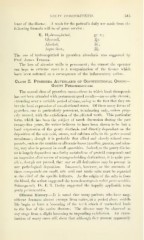Page 517 - My FlipBook
P. 517
;
GOUTY PERICEMENTITIS. 515
lenoe of the disease. A wash for the patient's daily use made from the
following formula will be of great service :
I^. Hydronaphthol, gr. x
;
Glycerol, Sj
Alcohol, 3ij
;
Aquse dest., oij.
The use of hydronajihthol in pyorrhea alveolaris was suggested by
Prof. James Truman.
The loss of alveolar walls is permanent ; the utmost the operator
can hope in extreme cases is a reorganization of the tissues which
have been softened as a consequence of the inflammatory action.
—
Class II. Pyorrhea Alveolaris of Constitutional Origin
Gouty Pericementitis.
The second class of pyorrhea cases—those in which local therapeusis
has not been attended with permanent good results—are usually chronic,
extending over a variable period of time, owing to the fact that they are
but the local expression of constitutional states. Of these many forms of
pyorrhea, one is particularly persistent, terminating only, unless prop-
erly treated, with the exfoliation of the affected teeth. This particular
form, which has been the subject of much discussion during the past
twenty-five years, the writer believes to have been shown to be but a
local expression of the gouty diathesis and directly dependent on the
deposition of the uric acid, urates, and calcium salts in the pericemental
membrane ; though it is probable that allied and closely related com-
pounds, such as the xanthin or alloxuric bases (xanthin, guanin, and aden-
in), may also be present in small quantities. Indeed, as the gouty diathe-
sis is largely dependent on a faulty metabolism of proteid compounds and
an imperfect elimination of nitrogen-holding derivatives, it is quite pos-
sible, though not proved, that any or all derivatives may be present in
any pathological deposition. Inasmuch, however, as the amounts of
these compounds are small, uric acid and uratic salts must be regarded
as the chief of the specific irritants. As the origin of the salts is from
the blood, the w^riter suggested the term hematoc/enie calcic j^ericementitis.
Subsequently Dr. E. T. Darby suggested the happily applicable term
gouty p ericement it is.
Clinical History.—It is noted that many patients who have mag-
nificent dentures almost exempt from caries, at a period about middle
life begin to have a loosening of the teeth which if unchecked leads
to the loss of the entire denture. The disease may be observed at
anv stage from a slight loosening to impending exfoliation. An exam-
ination of many cases will show that although they i)resent apparently
GOUTY PERICEMENTITIS. 515
lenoe of the disease. A wash for the patient's daily use made from the
following formula will be of great service :
I^. Hydronaphthol, gr. x
;
Glycerol, Sj
Alcohol, 3ij
;
Aquse dest., oij.
The use of hydronajihthol in pyorrhea alveolaris was suggested by
Prof. James Truman.
The loss of alveolar walls is permanent ; the utmost the operator
can hope in extreme cases is a reorganization of the tissues which
have been softened as a consequence of the inflammatory action.
—
Class II. Pyorrhea Alveolaris of Constitutional Origin
Gouty Pericementitis.
The second class of pyorrhea cases—those in which local therapeusis
has not been attended with permanent good results—are usually chronic,
extending over a variable period of time, owing to the fact that they are
but the local expression of constitutional states. Of these many forms of
pyorrhea, one is particularly persistent, terminating only, unless prop-
erly treated, with the exfoliation of the affected teeth. This particular
form, which has been the subject of much discussion during the past
twenty-five years, the writer believes to have been shown to be but a
local expression of the gouty diathesis and directly dependent on the
deposition of the uric acid, urates, and calcium salts in the pericemental
membrane ; though it is probable that allied and closely related com-
pounds, such as the xanthin or alloxuric bases (xanthin, guanin, and aden-
in), may also be present in small quantities. Indeed, as the gouty diathe-
sis is largely dependent on a faulty metabolism of proteid compounds and
an imperfect elimination of nitrogen-holding derivatives, it is quite pos-
sible, though not proved, that any or all derivatives may be present in
any pathological deposition. Inasmuch, however, as the amounts of
these compounds are small, uric acid and uratic salts must be regarded
as the chief of the specific irritants. As the origin of the salts is from
the blood, the w^riter suggested the term hematoc/enie calcic j^ericementitis.
Subsequently Dr. E. T. Darby suggested the happily applicable term
gouty p ericement it is.
Clinical History.—It is noted that many patients who have mag-
nificent dentures almost exempt from caries, at a period about middle
life begin to have a loosening of the teeth which if unchecked leads
to the loss of the entire denture. The disease may be observed at
anv stage from a slight loosening to impending exfoliation. An exam-
ination of many cases will show that although they i)resent apparently


